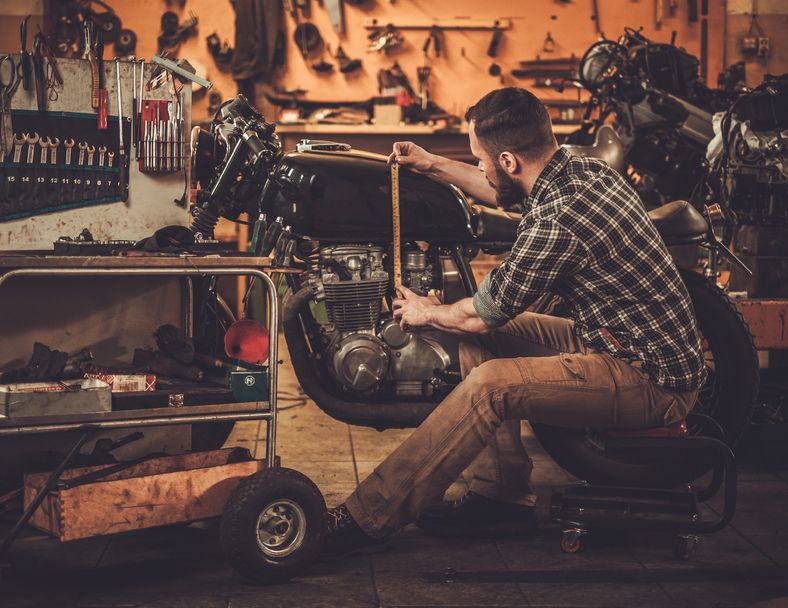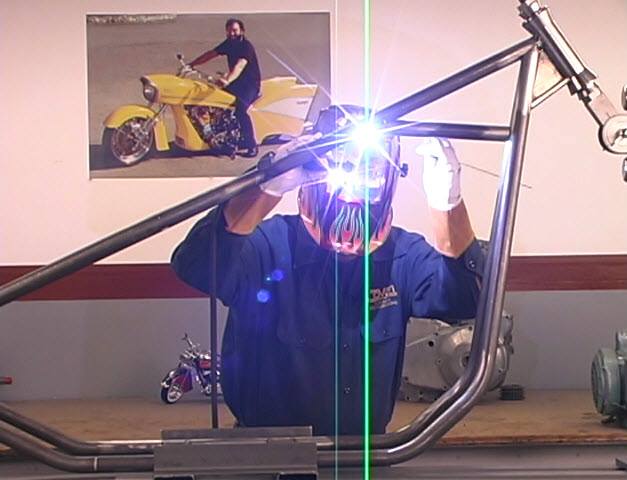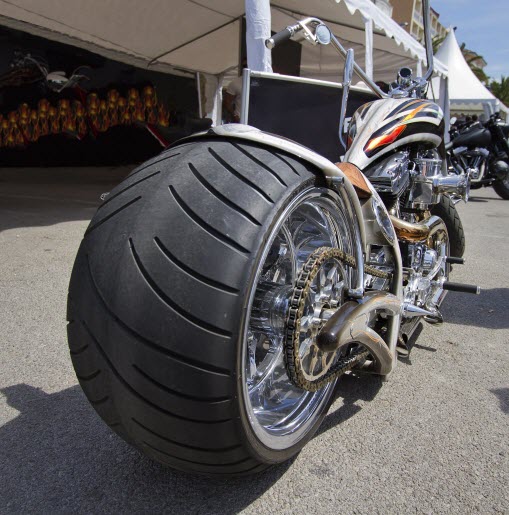9 Bike Building Tips and How To Avoid Common Motorcycle Building Mistakes.

Problem #1: What is the difference between common pipe and tubing?
A: This is also a very important and critical issue. There is a significant difference between pipe and tubing. The mechanical values are very different.
- Pipe is measured on the ID (inside diameter).
- Tubing is measured on the OD (outside diameter).
Even though most pipe is rated to withstand a great deal of internal pressure, its molecular structure is too brittle to be bent without damage.
Weakening common pipe may also fracture if not cut properly and is often difficult to weld. On the other hand, most tubing is suitable for cutting, bending and welding. These are necessary factors when
choosing material to build a motorcycle frame.
Problem #2: What type of tubing should I use?
A: The tubing choice for a 'strong' frame can vary from mild steel, chrom-moly, to stainless. The quality of each is important - seamless - hot rolled and smooth - called DOM (Drawn Over Mandrel). Each of the tubing choices have advantages....
- Mild steel (your best choice) is easy to work/bend, inexpensive, fairly strong, and easy to weld. It accepts all forms of welding well (flux wire/stick or gas Mig, Tig).
- Chrom-moly is a bit more expensive than mild steel, very strong but more difficult to bend than mild steel. Chrom-moly is best welded with Tig.
- Stainless tubing is expensive, very strong, more difficult to bend than chrom-moly. It requires Tig welding, and a lot of practice. Both Chrom-moly and Stainless are a bit overkill for a first time bike build or any street bike.
Problem #3: What is the best way to bend tubing?

A: First of all the best way to bend tubing is to use a 'tubing bender':
Heating and bending tubing for structural sections of a frame is not recommended. Heating any metal physically changes the molecular structure and many times modifies the strength and brittleness. Getting the right temperature is the key to not distorting the 'inner' strength of any tube. Where to heat and the direction to bend are additional variable when working with compound bends and seamed tubing.
If you are unsure of proper temps, bend directions and angles a tubing bender or mandrel tubing bender is the best way to go. Simple bends rarely interfere with the strength integrity of the material while retaining very good accuracy.
Stay away for inexpensive pipe benders - the dies will not fit tubing and the benders themselves are usually not heavy duty enough for any quality work. There are many quality manual tubing benders available for not much money.
There is really no need for a computer controlled, hydraulic mandrel bender unless you are looking to get into production work. For a good, quality tubing bender try JD Squared in Ocala, Florida
(www.jd2.com). Or go to this page.
Problem #4: What size tubing should I use?
A: Tubing size is a personal or design preference. Yes, larger diameter tubing with a thick wall will be stronger but sometimes this same tubing may be difficult to bend, fit, and weld. So a happy medium must be met - 1 3/8" x .120 is common and rather easy to work with, but again, other diameters are just as easy to work with but adjustments in the design/jig must be made. I use 1 1/2" x .120 (with a 2" single downtube and 1.75" backbone). The frames look real 'meaty', bend well, and are easily welded.
Tubing size and wall thickness also contribute to 'frame harmonics'. Big V-Twin engines produce a great deal of vibration. This vibration creates a harmonic vibration within the frame that can sometimes lead to weld failure. The best way to reduce (not eliminate) frame harmonics is to increase the wall thickness of the tubing used and concentrate on quality welds.
Problem #5: What type of welding method is best for frame building - Gas, Stick, MIG or TIG?

A: The welding methods vary as much as the materials. Basic material like mild steel is open to virtually all types of welding methods, Gas, Stick, Mig Welding, and Tig Welding. Materials like chrom-moly or stainless require more precise/advanced forms of welding methods such as Mig or Tig. Methods like Gas or Stick are not recommended for frame fabrication.
Wire feed - Mig (gas not flux core) is the most common in basic fabrication and adapts to a wider range of materials. Tig welding is by far the most desirable for a quality weld on any material...
In some shops, when welding mild steel or chrom-moly, they will use Mig to 'tack' materials together and use Tig for the final finish weld. It is recommended that you 'move around' when welding. This means
complete a weld at the neck, and then move to an area like an engine mount and so on. This evenly distributes the heat generated by the welding process and will greatly reduce the possibility of
any warping or twisting. Leave the frame in the jig until all material is cool to the touch.
With any welding method, practice is a must. Take your time to become comfortable with the welding method, equipment and material. It's more important to do it right the first time. 'Fast' comes with practice.
Problem #6: Which is better single or double downtubes?
A: This is one of those personal design preferences. Usually the overall design or style of the bike will dictate the downtube design. Dual downtubes resemble the stock design frame. Single downtubes are becoming a more popular style. This has become a very creative section of the frame for builders.
Making a single downtube modification to a dual downtube design frame is rather straight forward while the frame is in the jig. Like the double design, the single downtube is attached to the neck just like the backbone. Now the new single downtube is joined to the lower rails just a few inches above where the front motor mount is located. Just 'curve the 2 lower rails (that now point up like the downtube) inward to meet at the new single downtube. From a structural prospective the single design is just as strong and the double design. All of this is where you can get creative!
Problem #7: Is it important to notch the tubing?
A: A proper and tight tubing joint is one of the most important features of frame fabrication. There is simple 'notching', also called 'fish mouth' attachments (for a drill press) that use common hole saws (easily replaced) that are great for 'small' jobs. A milling machine, though more complex, can offer a cleaner cut with better control. Proper notching will insure strong and good penetrating welds without 'filler'. In any case I would make a test cut with scrap material - these joints are a little tricky!!! I would not attempt this 'by hand'.
Problem #8: What is the difference in engine mounts?
A: V-twin engine mounts are the same for the Knucklehead (1936-1947), the Panhead (1948-1965), the Shovelhead (1966-1985) and the Evolution (1984-1999). This configuration is identified by the engine being separate from the transmission. The Twin Cam 88 (1999-Present) and Twin Cam 88B (2000-Present) have a different mount design. This configuration is identified by the engine being attached to the transmission. And a third design and mount configuration is the Revolution Engine (2001-Present).
Problem #9: Do I have to offset the engine to fit a wide tire?

A: No! Keeping the engine centered is foremost important. A properly aligned and offset transmission will not need any offset in the engine. Depending on the finished width of the final drive will determine the amount of offset needed in the transmission.
- Tire sizes up to 280mm can use a left side drive (LSD) transmission.
- Tire sizes of 300mm and over require a right side drive (RSD) transmission.
- A 280mm tire can be used on either a LSD or RSD transmission.
Transmission and primary offsets come in 1/4" increments allowing you to 'move' the transmission location so the drive will fit to the wheel width. Along with transmission offset the are offset pulleys and sprockets that can usually allow you to gain an additional 1 inch. If that is still not enough, using a chain for the final drive will gain you up to an additional 3/4".
Virtually any offset configuration can be made. The goal is to not move the engine and move the transmission as little as necessary. It is possible to build a 'wide tire' design that does ride
balanced!
Related Articles:
Disclaimer: All information is provided here without any guarantee on the part of the publisher, editors, contributors and authors, who also disclaim any liability incurred in connection with the use of the information on this page, mini course, or website. THERE IS NO WARRANTY NEITHER WRITTEN, EXPRESSED OR IMPLIED FOR DAMAGES THAT MAY RESULT FROM THE APPLICATION AND INTERPRETATION OF THIS Information.
